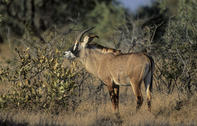The Future Mega-Park
The Great Limpopo Transfrontier Park, this mega-park will eventually straddle the borders of South Africa, Mozambique and Zimbabwe. It received approval in December 2002 when an international treaty was signed at Xai-Xai by all three heads of state.

The idea for the Great Limpopo Transfrontier Park (GLTP) began as early as 1932, when ecologist Gomes de Sousa proposed the idea of a Transfrontier Park to the Portuguese colonial authorities. Nothing came of the idea until 1990, when the then-President of Mozambique, Joaquim Chissano, met with the president of the World Wildlife Fund at the urging of Anton Rupert’s Transfrontier Park Foundation (forerunner of Peace Parks).
African Nations Unite

Feasibility studies were soon undertaken with the help of the World Bank and the Global Environment Facility. The time was not ripe, however, as Mozambique was still in the throes of a long civil war and South Africa was a much-hated pariah state. Thankfully, political tensions largely dissolved after the Mozambique peace accord of 1992 and the democratic South African elections of 1994.
So, in 2000, an initial Memorandum of Understanding (MoU) for the establishment of the Transfrontier Conservation Area was signed at Skukuza. A joint-management board and various management committees were subsequently set up to iron out the details, such as conservation practices, safety and security, finance, human resources, legislation and tourism – all the fun stuff.
Official Treaty Signing
After the official treaty signing in 2002, work on the new park began in earnest. The initial focus was on the consolidation and integration of the new 10 000 km² (1 000 000 hectare) Limpopo National Park, on the Mozambique side of the Kruger National Park. Originally named Coutada 16, this area was first fenced off as a hunting concession area in 1969.
No subsequent development took place until 2001, when the Parque Nacional do Limpopo (PNL) was declared and developed with the help of the German Federal Ministry for Economic Cooperation and Development. Park management is now busy with community development programmes, the training of rangers, conservation efforts, infrastructure development, the drafting of tourism plans and the removal of landmines left over from the civil war.
Dropping the Barrier

The 200 km border fence that separated the Kruger National Park and Limpopo National Park (LNP) started coming down in 2003 and this process is ongoing, although the scourge of rhino poaching has caused some to question the wisdom of dropping the barrier.
Communities living on the Mozambique side of the park were moved (after due consultation) and more than 6000 animals from the Kruger National Park (including elephant and roan antelope) were relocated into the under-stocked Mozambican bush. Many other species, such as buffalo, are also starting to migrate across the border of their own volition. On the Zimbabwe side, progress has been slowed down by the continuing political and economic problems of this once-great country.
Nevertheless, all things shall pass and one looks forward to the day when the Gonarezhou Game Reserve (the home of the elephant), Manjinji Pan Sanctuary, Malipati Safari area and the Sengwe communal lands are incorporated into the Great Limpopo Transfrontier Park. The first step in this process would be the construction of a bridge and border post over the Limpopo River into Zimbabwe.
The First Phase
When it’s all done, the Great Limpopo Transfrontier Park will cover an area of over 30 000 square kilometres. And that’s just the first phase. The second phase will see the park grow to include the Banhine and Zinave National Parks, the Massingir and Corumana areas and the interlinking lands.
The result will be one of the world’s largest conservation areas, extending over 100 000 square kilometres. When this great dream is realised, it seems certain that the Great Limpopo National Park will be declared a United Nations Educational, Scientific and Cultural Organisation (UNESCO) World Heritage Site, signifying its global importance and value.
By David Fleminger During the 1890s, things grew chaotic in the Republic of the Transvaal (present day Mpumalanga). Since the discovery of gold, Johannesburg h...
During the 1890s, things grew chaotic in the Republic of the Transvaal (present day Mpumalanga). Since the discovery of gold, Johannesburg h...